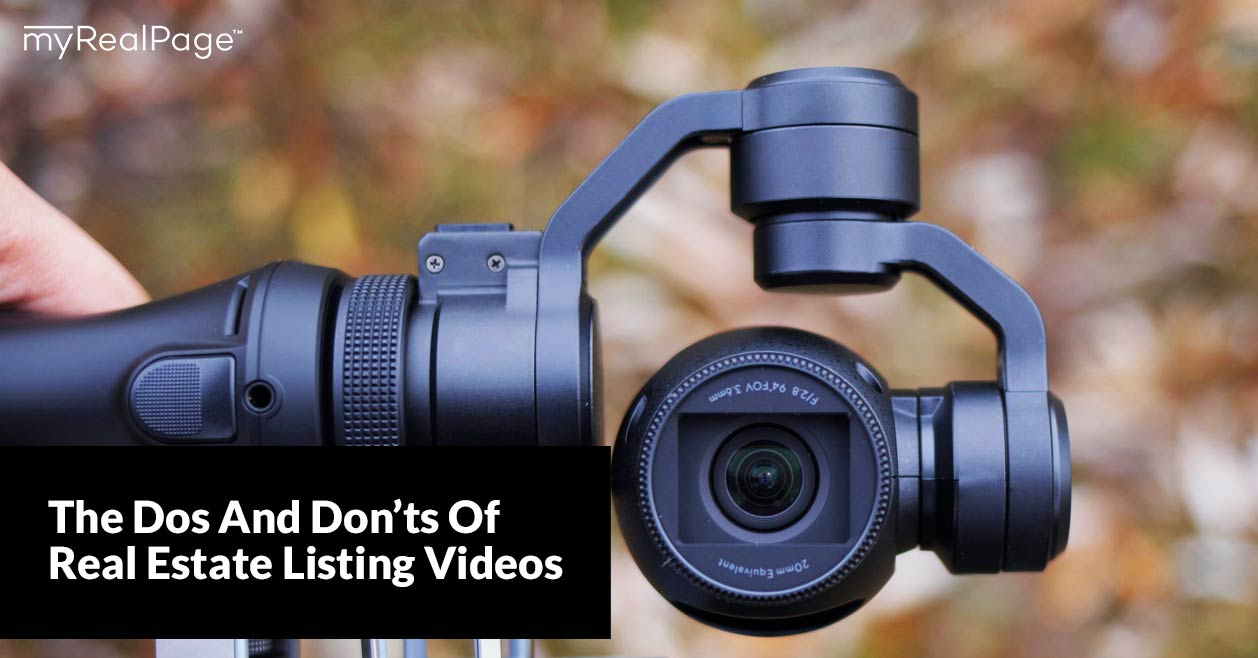The Dos and Don’ts of Real Estate Listing Videos

Thanks to technology becoming more accessible, and buyers becoming more discerning, real estate listing videos have gone from “nice to have” to “must have” for agents marketing their properties. What used to be a special add-on reserved for luxury listings is now a commonplace marketing tactic.
And while real estate agents may not be relishing that fact (yes, making videos requires a little more work), it’s hard to argue with the fact that real estate listing videos are effective.
They’re engaging. They convey the listing’s features in a way that still photos can’t. And they drum up interest from potential buyers that may have otherwise not taken a second look.
But that doesn’t mean you can just film a 30-second look-around on your iPhone and call it a listing video.
To maximize their effectiveness, you need to know the dos and don’ts of real estate listing videos. Keep reading!
DO Think About Where the Video Will Live
 Where you’ll share the video will dictate how you create the video. You need to make sure you’re shooting and editing in the right format.
Where you’ll share the video will dictate how you create the video. You need to make sure you’re shooting and editing in the right format.
Let’s say you want to publish the video to YouTube so that you can share it in a real estate blog post, newsletter or add the link to the real estate listing description. In that case, you’re going to want to film the video in landscape mode — that is, a horizontal video.
Filming a real estate listing video solely for Instagram (Stories, Reels, or grid posts)? Then you’ll want to shoot in portrait — or vertical — mode. Vertical videos will better fill the frame.
“What if I film my video the wrong way? Can I edit it?”
Yes… and no. Video editing apps (which we’ll talk about in a bit) will let you change the frame of your video, but this comes with limitations and drawbacks. For example, if you’ve filmed a horizontal video, applying a vertical frame means you’ll be restricting your footage to only what fits within that frame. That could really dampen the effectiveness of your video.
DON’T Only Show the Best Features
There’s a difference between a real estate listing video and a highlight reel.
Prospective buyers watch listing videos because they want to get a better sense of the house — all of the house. Only spotlighting the standout features doesn’t provide the kind of context they’re looking for.
While you don’t need to dwell on every square inch of the property, you need to convey a realistic experience of walking through the house. Don’t skip the guest bedroom because it’s not a showstopper like the master; prospective buyers will notice and have questions.
DO Use the Right Tools
The difference between feeling comfortable about creating real estate listing videos or feeling overwhelmed often comes down to the right tools.
You don’t need a fancy DSLR camera. You don’t need to know how to use Final Cut Pro. And you don’t need to hire someone.
A toolkit for creating great listing videos can be as simple as:
- Your smartphone. Camera phones have become so advanced that unless you’re creating a real estate listing video for a luxury listing (in that case, we’d recommend hiring a pro), your phone will likely suffice. Exceptions apply for older models, of course (we’d recommend using nothing older than an iPhone 8 Plus). If you have a DSLR camera with good video capability, that of course will work too.
- A gimbal (stabilizer). This hand-held contraption will help make smartphone videos much smoother and less jerky by stabilizing your phone as you walk and film. They require a small investment (good models typically start at $100) but are worth the money.
- Good lighting. It’s hard to rescue a video shot in a dark setting. Aim to shoot real estate listing videos on bright days where you can maximize natural light. You can play around with light fixtures, too, to help create the best lighting
- A video editing app. After a camera, a good video editing app is the next most important thing. We recommend InShot for editing videos from your mobile device. It’s packed with all the features you could possibly need and it’s very user-friendly to use. With some practice, you can turn your footage into professional-looking real estate listing videos with ease.
DON’T Narrate
Prospective buyers don’t need to hear you describe each and every feature (though if you’d like to create a video that’s accessible to those with vision loss, then description is a great idea). It’s distracting and detracts from the video.
Instead, let the video footage speak for itself, or add short on-screen descriptions during the editing process.
DO Add Music (But Be Choosy)
Your video is definitely going to need some background music to keep it engaging. But the wrong music can have the opposite effect.
The best music for real estate listing videos is music that’s forgettable. It sounds counterintuitive and pointless, but it’s true.
Whether you source a music track from your video editing app (most offer music libraries) or purchase a track from a site like Audio Jungle, look for something that is upbeat but basic — not too fast, not too slow, no crescendos, and no vocals.
Oh, and remember: you must have the rights to use the music.
DON’T Go Crazy With Effects
No fades. No swipes. No confetti, fireworks, stars, underlining or exclamation marks.
The only effects you should use in your real estate listing videos are on-screen text and footage editing features that improve the video’s quality (such as boosting the brightness or deepening the contrast).
DO Keep It Brief
Your real estate listing video should be a minute long at most.
Sounds short?
It is. But it’s enough time to give prospective buyers a sense of the house while making sure they don’t lose interest. (It also happens to be the maximum length for videos shared directly to your Instagram grid!)
DON’T forget a Call-to-Action
Last but certainly not least, don’t forget to include a call-to-action with your real estate listing video. You want to nudge viewers to take a further step.
A call-to-action could be on-screen text at the end of the video that tells viewers where to find more information (e.g., “Interested? Learn more at janesmithrealestate.com”).
Or if you’re sharing the video on Instagram, it could be something you include in the caption or via on-screen text (e.g., “Want to see this stunner in person? DM me!”).
Do you create real estate listing videos for every listing?
Last Updated on November 28, 2023 by myRealPage


